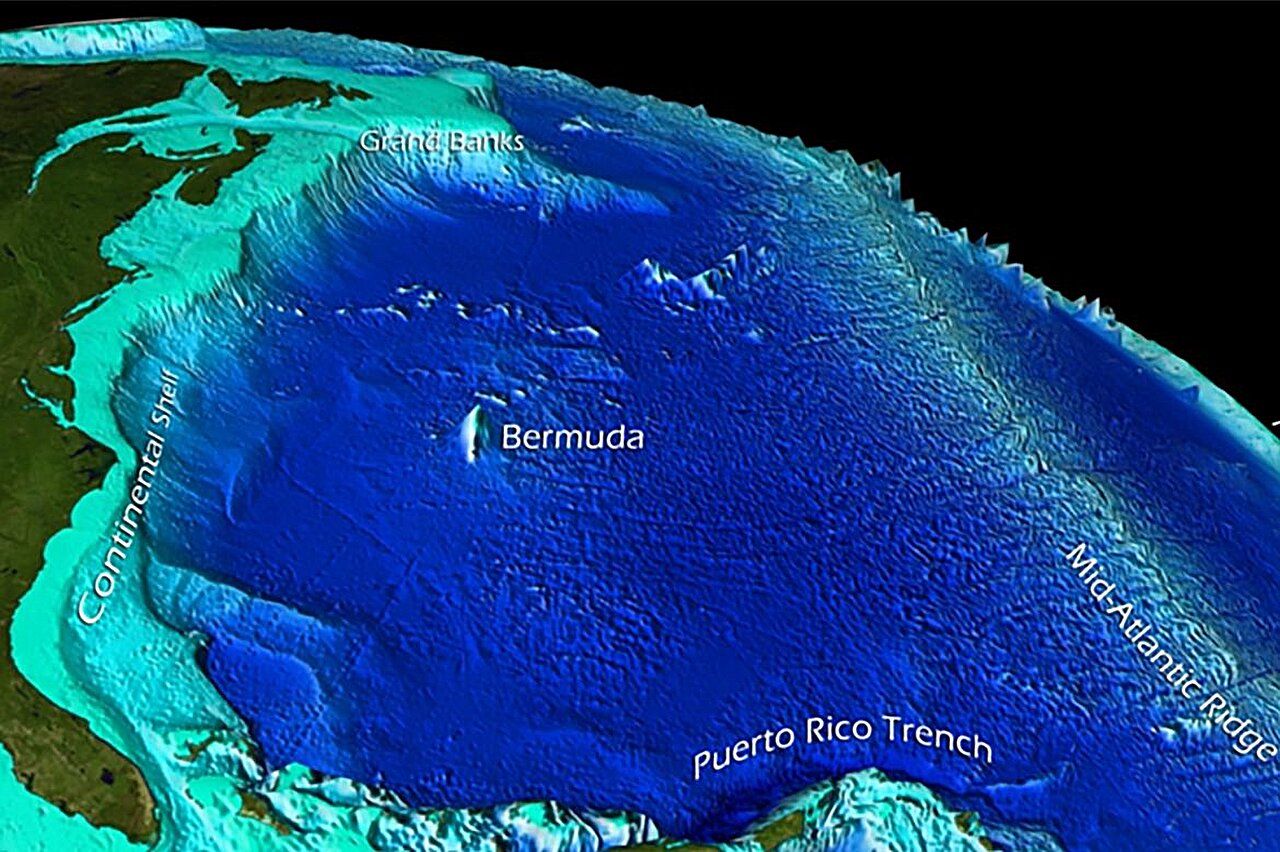Graphic depicting satellite-imaged bathymetric data for the western Atlantic basin and its ocean floor features. Credit: NOAA National Satellite and Information Service
× near
Graphic depicting satellite-imaged bathymetric data for the western Atlantic basin and its ocean floor features. Credit: NOAA National Satellite and Information Service
The movement of carbon between the atmosphere, oceans and continents – the carbon cycle – is a fundamental process that regulates Earth’s climate. Certain factors, such as volcanic eruptions or human activity, release carbon dioxide into the atmosphere. Others, such as forests and oceans, absorb this CO2. In a well-regulated system, the exact amount of CO2 is emitted and absorbed to maintain a healthy climate. Carbon sequestration is one tactic in the current battle against climate change.
A new study finds that the shape and depth of the ocean floor explain up to 50% of the changes in the depth at which carbon has been sequestered in the ocean over the past 80 million years. Previously, these changes were attributed to other causes. Scientists have long known that the ocean, Earth’s largest carbon sink, directly controls the amount of carbon dioxide in the atmosphere. But until now, it was not well understood exactly how changes in seafloor topography over Earth’s history affected the ocean’s ability to sequester carbon.
The work was published in Proceedings of the National Academy of Sciences.
“We were able to show for the first time that the shape and depth of the ocean floor play an important role in the long-term carbon cycle,” said Matthew Bogumil, the paper’s lead author and a UCLA postdoctoral fellow in Earth, Planetary and Space Sciences.
The long-term carbon cycle has many moving parts, all operating on different time scales. One of these parts is seafloor bathymetry – the average depth and shape of the ocean floor. This in turn is controlled by the relative positions of the continent and oceans, sea level, and the flow in the Earth’s mantle. Carbon cycle models calibrated with paleoclimate datasets form the basis of scientists’ understanding of the global marine carbon cycle and how it responds to natural perturbations.
“Typically, models of the carbon cycle in Earth history treat seafloor bathymetry as either a fixed or a secondary factor,” said Tushar Mittal, co-author of the paper and professor of geosciences at Penn State University.
The new research reconstructed the bathymetry over the past 80 million years and incorporated the data into a computer model that measures carbon sequestration in the sea. The results show that ocean alkalinity, calcite saturation state, and depth of carbonate compensation depend strongly on changes in the shallow parts of the ocean floor (about 600 meters or less) and how the deeper sea regions are distributed (more of 1000 meters). These three measures are critical to understanding how carbon is stored on the ocean floor.
A graphic showing several features of the ocean floor on a scale of 0–35,000 feet below sea level. Credit: NOAA Office of Education
× near
A graphic showing several features of the ocean floor on a scale of 0–35,000 feet below sea level. Credit: NOAA Office of Education
The researchers also found that for the current geologic era, the Cenozoic, bathymetry alone accounts for 33%–50% of the observed variation in carbon sequestration, and concluded that by ignoring bathymetric changes, researchers are misattributing changes in carbon sequestration to other, less certain factors, such as atmospheric CO2temperature of the water column and silicates and carbonates washed into the ocean by rivers.
“Understanding important processes in the long-term carbon cycle can better inform scientists working on marine-based carbon dioxide removal technologies to combat climate change today,” Bogumil said. “By studying what nature has done in the past, we can learn more about the possible outcomes and practicalities of marine uptake to mitigate climate change.”
This new understanding that the shape and depth of the ocean floor is perhaps the biggest influence on carbon sequestration may also aid the search for habitable planets in our universe.
“When we look at distant planets, we currently have a limited set of tools to tell us about their habitability potential,” said co-author Carolina Lithgow-Bertelloni, UCLA professor and chair of the Department of Earth, Planetary and Space Sciences. “Now that we understand the important role that bathymetry plays in the carbon cycle, we can directly link a planet’s internal evolution to its surface environment when inferring JWST observations and understanding the habitability of the planet as a whole.”
The breakthrough represents just the beginning of the researchers’ work.
“Now that we know how important bathymetry is in general, we plan to use new simulations and models to better understand how differently shaped ocean floors will specifically affect the carbon cycle and how this has changed over Earth’s history, particularly in the early Earth, when most of the land was under water,” Bogumil said.
More info:
Matthew Bogumil et al, Effects of bathymetry on the long-term carbon cycle and CCD, Proceedings of the National Academy of Sciences (2024). DOI: 10.1073/pnas.2400232121
Log information:
Proceedings of the National Academy of Sciences



